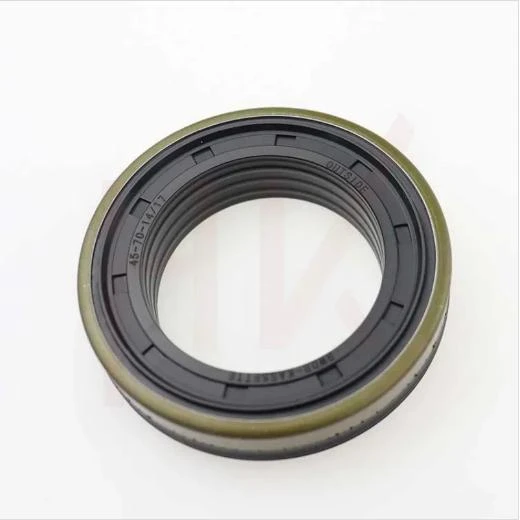Desemba . 06, 2024 17:32 Back to list
seal hydraulic pump
Understanding Seal Hydraulic Pumps Functionality and Applications
Hydraulic pumps play a crucial role in various industries by converting mechanical energy into hydraulic energy, enabling the efficient transfer of fluids. Among the different types of hydraulic pumps, seal hydraulic pumps are particularly noteworthy due to their effective sealing mechanisms, which significantly enhance performance, reliability, and longevity. This article delves into the functionality, types, and applications of seal hydraulic pumps.
What is a Seal Hydraulic Pump?
A seal hydraulic pump is a type of hydraulic pump designed with specialized sealing mechanisms to prevent leaks and maintain pressure within the hydraulic system. The primary function of this pump is to draw in a hydraulic fluid, such as oil, and propel it under high pressure to different parts of a system. The seal is critical because it minimizes the loss of hydraulic fluid, ensuring that the system operates efficiently and effectively.
How Do Seal Hydraulic Pumps Work?
The workings of a seal hydraulic pump can be understood through its key components the pump housing, impeller or gear mechanism, and seals. The pump housing contains the hydraulic fluid and houses the mechanisms responsible for moving the fluid. Depending on the type of seal hydraulic pump, it may use an impeller (in the case of centrifugal pumps) or gears (in gear pumps) to draw in fluid and push it through the system.
Seals are vital in this process. They can be lip seals, O-rings, or mechanical seals, depending on the design and application of the pump. These seals prevent the hydraulic fluid from leaking out of the pump, which not only conserves fluid but also prevents contamination and loss of pressure. High-quality seal materials are essential for maintaining durability and performance, as they must withstand various pressures and temperatures.
Types of Seal Hydraulic Pumps
Seal hydraulic pumps can be categorized into several types based on their design and function
1. Gear Pumps These pumps use two gears to transfer hydraulic fluid. The meshing of the gears creates a vacuum that draws fluid into the pump and pushes it out at high pressure. Gear pumps are known for their reliability and are often used in mobile equipment applications.
seal hydraulic pump

2. Vane Pumps Vane pumps use a rotating mechanism with vanes to draw fluid into the pump housing. The vanes slide in and out of the rotor, creating varying chamber sizes that help move the fluid. Seal integrity is crucial in vane pumps to maintain efficiency.
3. Piston Pumps These pumps employ a series of pistons that move back and forth to create pressure. Piston pumps are highly efficient and can generate very high pressures, making them suitable for various industrial applications. The seals used in piston pumps must endure significant wear and pressure.
4. Centrifugal Pumps Unlike positive displacement pumps, centrifugal pumps use rotational energy to move fluid. They are commonly used in applications where a steady flow is required rather than high pressure. The seals in centrifugal pumps are engineered to prevent leaks during continuous operation.
Applications of Seal Hydraulic Pumps
Seal hydraulic pumps find applications across numerous industries due to their efficient fluid handling capabilities. Common applications include
- Construction and Heavy Machinery Hydraulic pumps are vital in excavators, bulldozers, and other heavy equipment, where they power hydraulic systems for lifting, digging, and moving materials. - Manufacturing In manufacturing facilities, seal hydraulic pumps are used in hydraulic presses, injection molding machines, and other equipment that requires precise control of hydraulic power.
- Automotive Hydraulic pumps are essential in automotive systems, such as power steering and braking systems, ensuring safe and responsive vehicle operation.
- Agriculture Hydraulic systems powered by seal hydraulic pumps operate various farm machinery, including tractors and harvesters, enhancing efficiency in farming operations.
Conclusion
Seal hydraulic pumps are integral to modern engineering and industrial applications due to their ability to efficiently transfer hydraulic fluid while minimizing leakages and loss of pressure. Understanding their functioning, various types, and applications helps industries make informed choices in their hydraulic systems. As technology continues to advance, the design and materials used in seal hydraulic pumps will inevitably evolve, further enhancing their capabilities and reliability in various applications.
-
Unlocking the Potential of Hydraulic Systems with Essential Sealing Solutions
NewsAug.06,2025
-
Unleash the Power of Your Hydraulic Systems with Our Premium Seal Kits
NewsAug.06,2025
-
Specialized Hydraulic Seal Kits for Breakers, Pistons, and Presses
NewsAug.06,2025
-
Revitalize Hydraulic Systems with Premium Repair and Seal Kits
NewsAug.06,2025
-
Fortify Your Cylinders with Premium Sealing Solutions
NewsAug.06,2025
-
Elevate Hydraulic System Reliability with Specialized Seal Kits
NewsAug.06,2025
-
TCN Oil Seal Metal Ring Reinforcement for Heavy Machinery
NewsJul.25,2025
Products categories
















